Countering the perception of policy paralysis, the Indian government has gone in for a major makeover with a mega cabinet reshuffle that has brought in 17 new faces and five ministers being elevated to cabinet rank. Prime Minister Manmohan Singh called his new team “a mix of youth and experience” and made it clear that this would be the last rejig before the next poll battle in 2014.
Congress general secretary Rahul Gandhi, the perennial prime minister-in-waiting, did not join the government – leaving the field open for him to play a larger role in the party.
Several key portfolios changed hands, some new faces were introduced, some elevated to cabinet rank and at least one old face – Shashi Tharoor – was back in an exercise that jettisoned tainted ministers like Subodh Kant Sahay and roped veterans like Ambika Soni and S.M. Krishna back into the party organisation to gear up for the 2014 electoral battle.
“It is a combination of youth and experience,” Manmohan Singh said after the ceremony at the Rashtrapati Bhavan where President Pranab Mukherjee administered the oath of office.
“The road ahead is full of challenges,” he said, expressing hope that this was the last such exercise before his UPA-II government heads for elections.
Of the seven new ministers sworn in with cabinet rank, two are debutants – former Rajya Sabha deputy chairperson K. Rahman Khan and Congress MP Chandresh Kumari Katoch. The other five – Ajay Maken, M.M. Pallam Raju, Dinsha Patel, Harish Rawat and Ashwini Kumar – have been elevated to cabinet rank.
Fifteen ministers of state were also sworn in.
In the reshuffle of berths, Khurshid, who has been battling allegations of graft, got external affairs. His previous ministry, law, went to Ashwani Kumar. Khurshid had served as junior foreign minister under P.V. Narasimha Rao in the 1990s.
Pallam Raju was made human resource development (HRD) minister in place of Kapil Sibal, who was left only with communication and IT. Pallam Raju’s minister of state in HRD was Tharoor, who had to resign as minister of state for external affairs in 2010 over a controversy regarding his alleged conflict of interests in the affairs of the Kochi IPL cricket team.
The crucial railways ministry, which had long been with one-time ally Trinamool Congress, was given to P.K. Bansal.
M. Veerappa Moily was given petroleum, while his previous responsibilities of corporate affairs and power were split – Sachin Pilot was elevated as minister of state with independent charge of corporate affairs and Jyotiraditya Scindia got independent charge of power.
These two ministers are known to be close to Rahul Gandhi.
Rawat was made water resources minister and Katoch union culture minister. Maken was elevated as housing and poverty alleviation minister and Dinsha Patel as mines minister.
S. Jaipal Reddy got science and technology and Kamal Nath got additional charge of parliamentary affairs besides urban development.
Amongst the ministers of state sworn in were Congress spokesperson Manish Tewari who got independent charge of information and broadcasting. Earlier with Soni, the ministry has been downgraded.
Telugu actor Chiranjeevi, whose PRP merged with the Congress, got independent charge of the tourism ministry. Tourism is one of the country’s major foreign exchange earners.
Special attention was paid to Andhra Pradesh, where Y.S. Jaganmohan Reddy has been gaining in influence and where Telangana issue has split ranks. It got the maximum representation of six with five new faces and one elevated to the cabinet rank.
Besides Pallam Raju, there was Chiranjeevi, Kotla Jaya Surya Prakash Reddy, Sarve Satyanarayana, Porika Balram Naik and Killi Kruparani.
There were also three new faces from West Bengal – Adhir R. Chowdhury, Deepa Dasmunsi and A.H. Khan Chowdhury, all known to be fiercely opposed to state chief minister Mamata Banerjee, whose Trinamool Congress broke ranks with the ruling coalition recently to bring about several ministerial vacancies.
Apex industry chamber CII welcomed the reshuffle and said: “India’s young demographics is starting to get reflected in the political leadership of the country, which is only natural.”
The opposition was not so impressed.
Describing the rejig as a “desperate move”, BJP spokesperson Nirmala Sitharaman said “no major decision was taken and no corrupt minister dropped”.
Activist-politician Arvind Kejriwal, who had earlier this month produced documents of alleged financial bungling by a trust run by Khurshid and his wife, was equally scathing.
“Corrupt people are not just protected but also rewarded,” he tweeted.
Opportunity lost or a concerted move towards change? The upcoming assembly elections in Himachal Pradesh and Gujarat will be the Congress-led government’s first major electoral test.
Author Profile

- Manish Chand is Founder and Editor-in-Chief of India Writes Network (www.indiawrites.org) and India and World, a pioneering magazine focused on international affairs. He is CEO, Centre for Global India Insights, an India-based think tank focused on global affairs.
Latest entries
 India and the WorldDecember 12, 2025India-Italy bonding: Tajani’s visit raises the bar for business, maritime ties
India and the WorldDecember 12, 2025India-Italy bonding: Tajani’s visit raises the bar for business, maritime ties In ConversationNovember 26, 2025G20 is a Force for global Good
In ConversationNovember 26, 2025G20 is a Force for global Good articlesNovember 26, 2025Rescuing G20 from North-South divide: Ubuntu Moment
articlesNovember 26, 2025Rescuing G20 from North-South divide: Ubuntu Moment India and the WorldOctober 27, 2025Modi hails the century of India and ASEAN, backs ASEAN centrality
India and the WorldOctober 27, 2025Modi hails the century of India and ASEAN, backs ASEAN centrality







